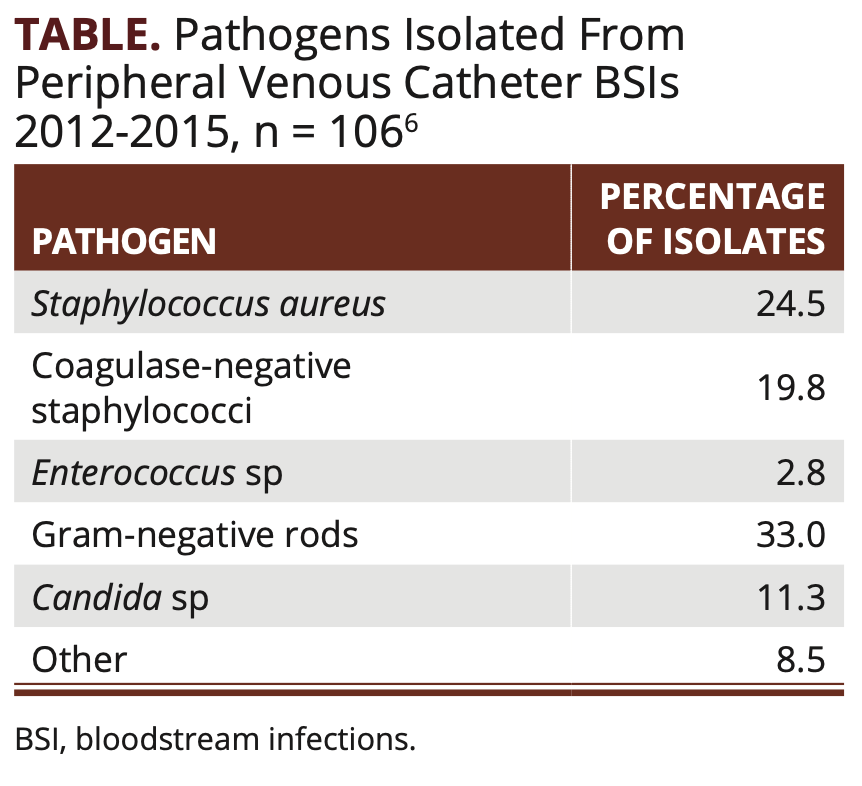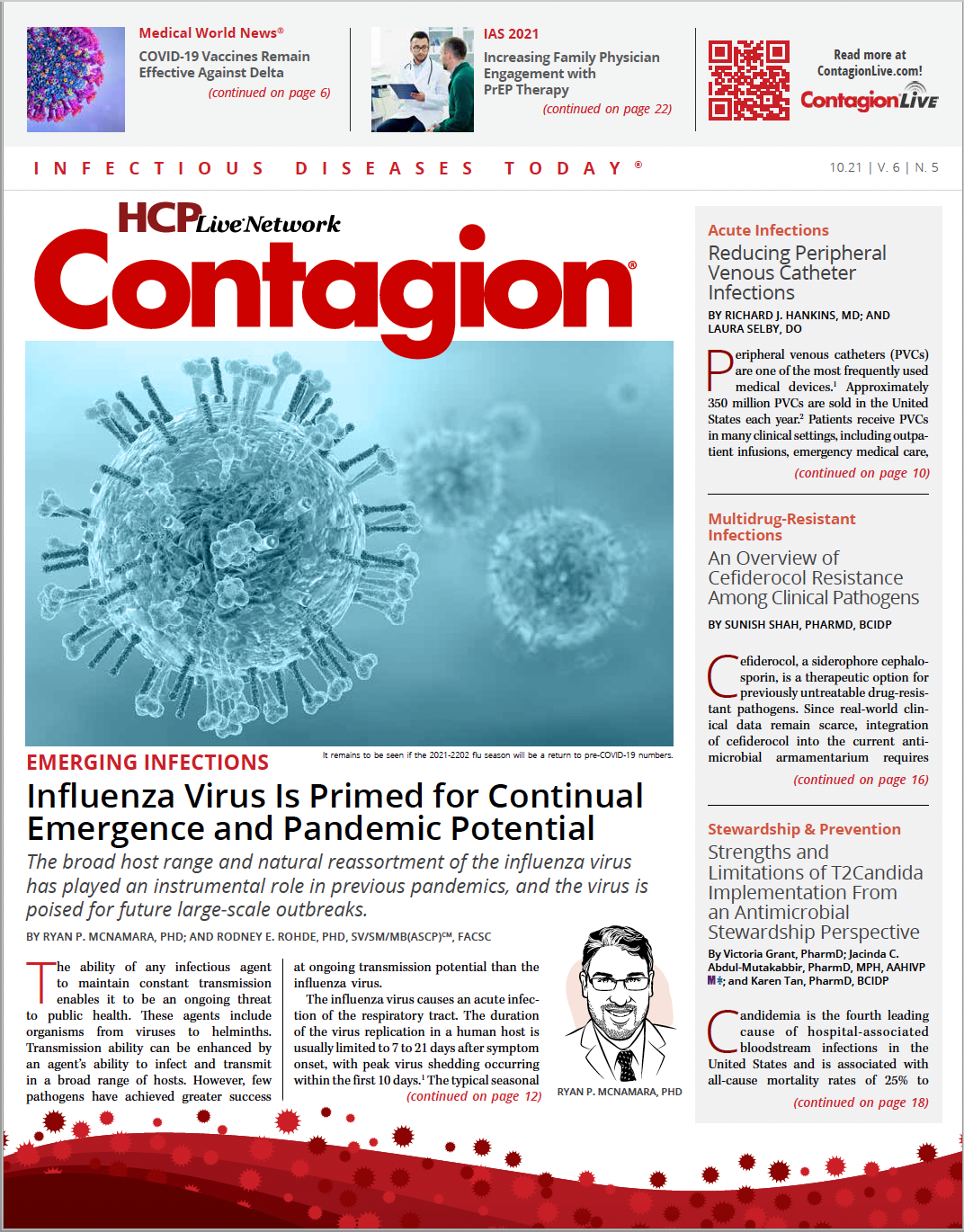Reducing Peripheral Venous Catheter Infections
Lack of data may mean bloodstream infections caused by PVCs are an overlooked cause of morbidity in hospitalized patients.
Introduction and clinical relevance
Peripheral venous catheters (PVCs) are one of the most frequently used medical devices.1 Approximately 350 million PVCs are sold in the United States each year.2 Patients receive PVCs in many clinical settings, including outpatient infusions, emergency medical care, and inpatient care, with 30% to 80% of hospitalized patients requiring PVC insertion during their stay.1 In fact, an estimated 80% to 90% of all vascular catheters are PVCs, far exceeding central venous catheters (CVCs).3 Despite the large number of PVCs utilized yearly, data for infectious complication rates are less robust than with the less-prevalent central venous catheters. This can be at least partially attributed to the requirement of acute care hospitals to track and report central-line associated bloodstream infections (CLABSIs) but not peripheral venous catheter–bloodstream infections (PVC-BSI).4
Central Venous Catheter vs Peripheral Venous Catheter Bloodstream Infections
BSIs from PVCs are reported at lower rates than for CVCs.3 However, the rate of PVC-BSI varies widely around the world. Results of studies of PVCs performed in the United Kingdom, US, and Australia have shown rates of 0.2 to 0.7 per 1000 catheter days.1 A prospective study in resource-limited areas of Southeast Asia found 2.65 PVC-BSI events per 1000 catheter days for patients in intensive care units.5 Although in resource-rich countries the overall risk of PVC-BSI is low, considering that up to 350 million PVCs could be placed per year in the United States, the potential for morbidity and mortality from PCV-BSI could easily rival that of CLABSI. If only half of purchased PVCs in the US are placed successfully, a conservative estimate, with an average dwell time of 3 days and a rate of 0.4 PVC-BSI events per 1000 catheters days, then 210,000 PVC-BSI potentially could occur each year in the United States alone.1,2,6 Compare this with the estimated 30,100 used in the US in 2018.7 Please note, this is an estimate based on limited data to illustrate the possible magnitude of PVC-BSI; the true number of PVC-BSI is unknown.

Data on the causative organism of PVC-BSI are more limited than for CLABSI.8 In adult patients, gram-positive cocci are the primary cause of PVC-BSI (Table 1). However, gram-negative rod bacteremia occurred at nearly twice the rate, 33.0% vs 18.8% compared with CLABSI . Results of a 2021 pediatric study identified gram-negative bacteria as more prevalent than gram-positive bacteremia, with 59.3% of PVC-BSI being caused by gram-negative bacteria.9 This study included a large number of children with chronic illnesses and recent health care exposures, which may have contributed to the higher-than-expected gram-negative bacteremia. Regardless, results of studies in both children and adults demonstrate gram-negative bacteremia as a substantial cause of PVC-BSI. Patients with PVC-BSI caused by Staphylococcus aureus are more likely to have metastatic seeding of the infection and higher mortality than PVC-BSI caused by other pathogens.3,10
Placement and Management of Peripheral Vascular Catheters
As with all vascular catheters, one should consider the type of access required prior to the placement of the catheter. PVCs are appropriate for patients who have an anticipated vascular access need of less than 6 days and do not require medications that should be infused via central access. Midline catheters should be considered if access is known to be needed for more than 6 days, but central venous access is not required.11
Reductions in CLABSI rates have been achieved through implementing care bundles designed to standardize practices and ensure infection prevention strategies are utilized during placement and maintenance of a CVC. Placement and maintenance bundles for PVCs are less well-studied, and lack of consistency across components and end points has made systematic review problematic.12 More research is needed to determine if bundles are effective at PVC-BSI prevention, and if so what elements of a bundle are needed to reduce complications.4,12 A study published in July 2021 demonstrated that alcohol-based chlorhexidine for skin preparation prior to PVC placement decreased both BSI and catheter colonization compared with iodine-based skin antiseptic preparation.13 Guidelines recommend hand hygiene, alcohol-based chlorhexidine skin prep, disinfection of needleless connectors, and implantation of a PVC insertion bundle; however, the guidelines acknowledge the lack of evidence for specific bundle components.4
Patients who have difficult venous access sometimes have a central venous catheter or peripherally inserted central venous catheter placed due to inability to place a PVC.14 For patients with difficult venous access, multiple attempts to place a PVC can cause physical and emotional distress; for some patients this distress is enough to delay hospitalized care.15 Placement of PVCs under ultrasound guidance decreases need for CVCs in patients with difficult venous access.14
Dwell Times
The dwell time has a complicated association with PVCs and PVC-BSIs. Results of studies have shown that longer indwell times are associated with both an increase in catheter colonization and increased rates of PVC-BSIs.16,17 However, current evidence suggests that removal of PVCs does not result in the same benefits seen in removal of CVCs. Routine removal and replacement of PVCs every 72 to 96 hours to prevent complications has similar rates of PVC-BSI when compared with clinically indicated removal.1,18 Clinically indicated removal means that a PVC would be removed if signs of infection, inflammation, blockage, or infiltration are present.17 PVCs should be inspected each shift to assess for complications and removed if complications are noted.17 Clinically indicated removal does not increase risk of PVC-BSI, but the overall exposure to PVC is a risk factor for PVC-BSI.1 When no longer clinically needed, PVCs should be removed, as unused catheters remain a risk for infection even when not in use.1
What’s Next?
PVC-BSIs are studied less than CVC-associated infections, yet the number of PVCs placed yearly far exceeds those of CVCs. Based on available data, bloodstream infections due to PVCs outnumber those from CVCs. The medical community needs to be aware of the serious risks and complications from PVCs, and as such PVCs should be treated with similar respect afforded to CVCs. PVCs should be removed when no longer clinically necessary because the total number of catheter days increases the risk of PVC-BSI. Similarly, they should not be inserted unless there is a clinical necessity. Based on recent literature, it would be reasonable to consider chlorhexidine and alcohol for skin preparation prior to PVC insertion, although further research will need to be done to evaluate if this is lowering only localized insertion site infections or PVC-BSI as well. PVCs should be assessed daily and removed when they are no longer clinically indicated as routine replacement does not decrease rates of PVC-BSI. Further research is desperately needed to identify if bundles are effective strategies to decrease PVC-BSI and, if so, which components are needed to reduce infection rates.
References
- Zhang L, Cao S, Marsh N, et al. Infection risks associated with peripheral vascular catheters. J Infect Prev. 2016;17(5):207-213. doi:10.1177/1757177416655472
- Steere L, Ficara C, Davis M, Moureau N. Reaching one peripheral intravenous catheter (PIVC) per patient visit with LEAN multimodal strategy: the PIV5rights bundle. J Vasc Access. 2019;24(3):31-43. doi:10.2309/j.java.2019.003.004
- Mermel LA. Short-term peripheral venous catheter-related bloodstream infections: a systematic review. Clin Infect Dis. 2017;65(10):1757-1762. doi:10.1093/cid/cix562
- Gorski L, Hadaway L, Hagle ME, et al. Infusion Therapy Standards of Practice, 8th Edition. J Infus Nurs. 2021;44(suppl 1S):S1-S224. doi:10.1097/NAN.0000000000000396
- Rosenthal VD, Bat-Erdene I, Gupta D, et al. Six-year multicenter study on short-term peripheral venous catheters-related bloodstream infection rates in 727 intensive care units of 268 hospitals in 141 cities of 42 countries of Africa, the Americas, eastern Mediterranean, Europe, south east Asia, and western Pacific regions: International Nosocomial Infection Control Consortium (INICC) findings. Infect Control Hosp Epidemiol. 2020;41(5):553-563. doi:10.1017/ice.2020.20
- Hopkinson S, Green AK, Hewitt BE, Grace SA. Short peripheral catheter dwell time and associated complications: a systematic review. J Infus Nurs. 2020;43(4):200-207. doi:10.1097/NAN.0000000000000374
- Current HAI progress report. CDC. Updated December 2, 2020. Accessed 22 August 2021. https://www.cdc.gov/hai/data/portal/progress-report.html
- Tsuboi M, Hayakawa K, Mezaki K, et al. Comparison of the epidemiology and microbiology of peripheral line- and central line-associated bloodstream infections. Am J Infect Control. 2019;47(2):208-210. doi:10.1016/j.ajic.2018.08.016
- Berger I, Cohen T, Rahmani E, et al. Peripheral venous catheter-related bloodstream infections in hospitalized children: the role of gram-negative bacteria. Pediatr Infect Dis J. Published online July 6, 2021. doi:10.1097/INF.0000000000003255
- Sato A, Nakamura I, Fujita H, et al. Peripheral venous catheter-related bloodstream infection is associated with severe complications and potential death: a retrospective observational study. BMC Infect Dis. 2017;17(1):434. doi:10.1186/s12879-017-2536-0
- Cawcutt KA, Hankins RJ, Micheels TA, Rupp ME. Optimizing vascular-access device decision-making in the era of midline catheters. Infect Control Hosp Epidemiol. 2019;40(6):674-680. doi:10.1017/ice.2019.49
- Ray-Barruel G, Xu H, Marsh N, Cooke M, Rickard CM. Effectiveness of insertion and maintenance bundles in preventing peripheral intravenous catheter-related complications and bloodstream infection in hospital patients: a systematic review. Infect Dis Health. 2019;24(3):152-168. doi:10.1016/j.idh.2019.03.001
- Guenezan J, Marjanovic N, Drugeon B, et al. Chlorhexidine plus alcohol versus povidone iodine plus alcohol, combined or not with innovative devices, for prevention of short-term peripheral venous catheter infection and failure (CLEAN 3 study): an investigator-initiated, open-label, single centre, randomised-controlled, two-by-two factorial trial. Lancet Infect Dis. 2021;21(7):1038-1048. doi:10.1016/S1473-3099(20)30738-6
- Galen BT, Southern WN. Ultrasound-guided peripheral intravenous catheters to reduce central venous catheter use on the inpatient medical ward. Qual Manag Health Care. 2018;27(1):30-32. doi:10.1097/QMH.0000000000000156
- Plohal A. A qualitative study of adult hospitalized patients with difficult venous access experiencing short peripheral catheter insertion in a hospital setting. J Infus Nurs. 2021;44(1):26-33. doi:10.1097/NAN.0000000000000408
- Safdar N, McKinley LM, Davidson B, Broome C, Schenk J. Recommendations to replace peripheral venous catheters every 72-96 hours: is a single reference enough? J Hosp Infect. 2011;79(2):172-173. doi:10.1016/j.jhin.2011.06.005
- Maki DG, Ringer M. Evaluation of dressing regimens for prevention of infection with peripheral intravenous catheters. Gauze, a transparent polyurethane dressing, and an iodophor-transparent dressing. JAMA. 1987;258(17):2396-2403.
- Webster J, Osborne S, Rickard CM, Marsh N. Clinically‐indicated replacement versus routine replacement of peripheral venous catheters. Cochrane Database of Syst Rev. 2019;1(1):CD007798. doi:10.1002/14651858.CD007798.pub5

